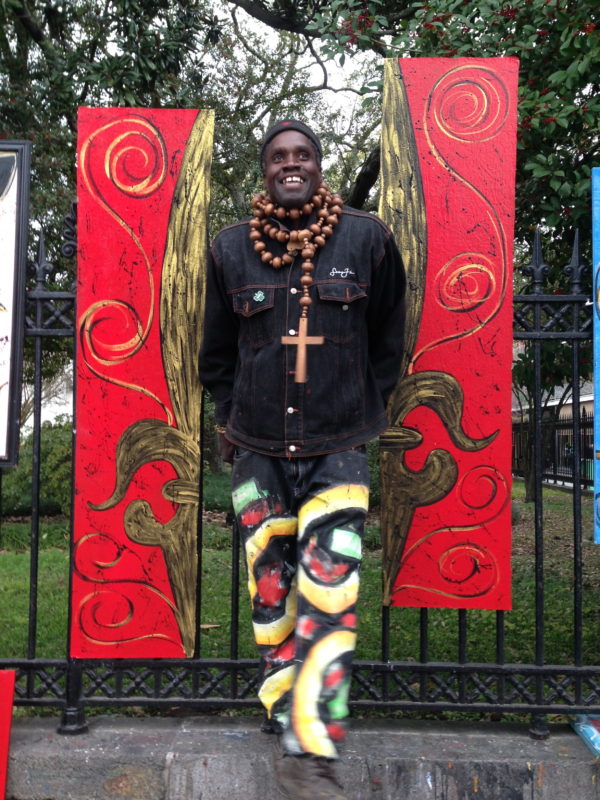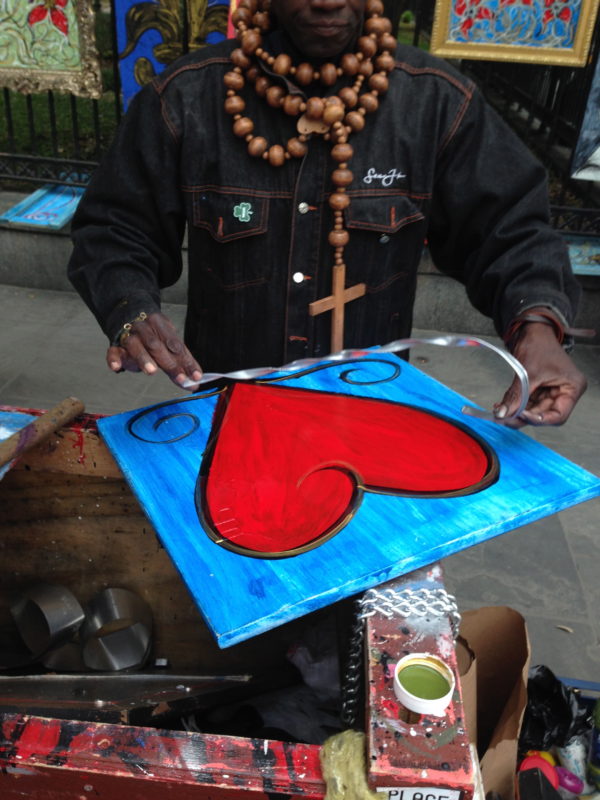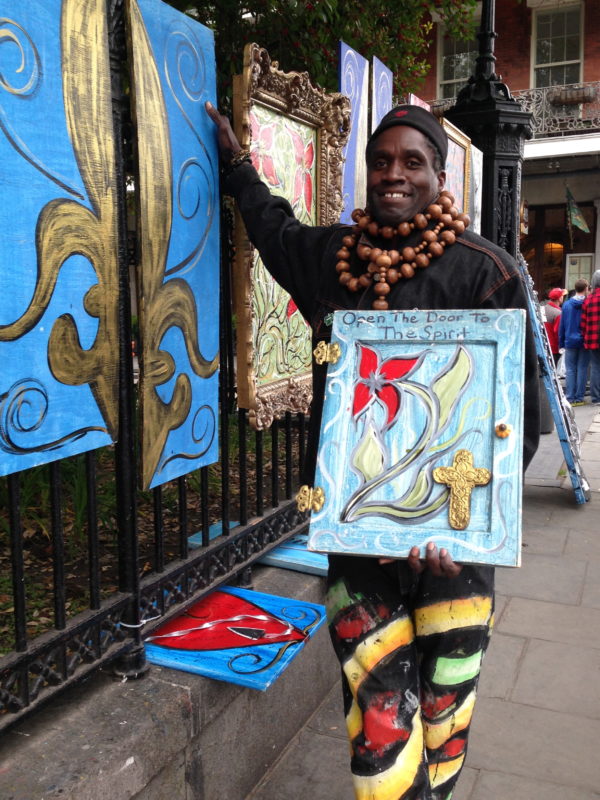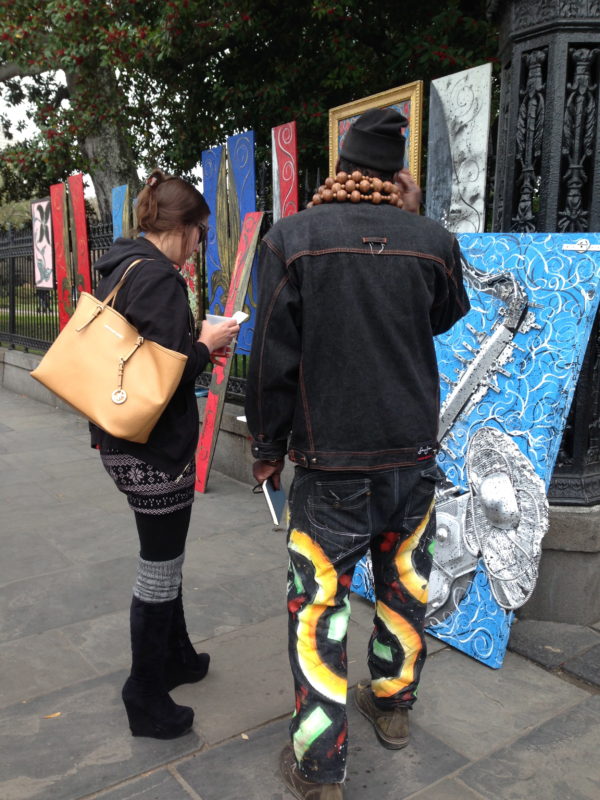
Rick Fox stands between a two part fleur de lis painting outside Jackson Square. Photograph taken by Emma Discher with permission from Rick Fox
Rick Fox, a painter, sculptor and dance instructor, has set up shop and studio on the sidewalk hugging the perimeter of Jackson Square in New Orleans since 2002, among as many as 200 artists on the weekends. He is part of the community of artists who work and sell here to tourists and locals alike. Fox is principally a sculptor but has taken to painting on hurricane debris with a splash of 3-dimensional sculpting. His art comes to life on cabinet doors and wooden planks with the incorporation of metal tubing, keys and bicycle chains

Many of Fox’s works combine painting with 3D elements. Photograph taken by Emma Discher with permission from Rick Fox
“All my work is on hurricane debris. This all came from the city and was discarded after the storm. So with that the work is always changing because the pieces are all different. Next weekend you’ll see another set because it sells very fast.”
On a particularly gray day in March, Fox himself is a work of art in splatter painted jeans, a denim jacket and an over sized wooden rosary wrapped around his neck like a cozy scarf. He towers above his patrons who walk by but he keeps a genuine grin on his face as he works on more pieces right on the sidewalk. Fox has become part of the mystical attraction of New Orleans and the artists in Jackson Square.
Daily Work

Rick Fox holds up one of his commissioned pieces. Fox said 10 percent of his work is via commission. Photograph taken by Emma Discher with permission from Rick Fox
Fox splits his week between 15-hour days in his studio on Jefferson Davis and 18-20 hour days at Jackson Square. His exact schedule varies depending on the time of the year but he never stops working. He turns his portion of sidewalk in Jackson Square into his second studio and creates up to 20 pieces in a single week. He works through hot and humid temperatures of the summer and below freezing windy days in the winter, relying on his double-layered jeans for warmth and upbringing in Alaska.
“There’s no job harder than this one. I know that because I’ve worked all my life and I’ve done everything from work in nurseries to fishing vessels, canneries to cooking, maître d to resale/sale to you name it. This is more labor intensive. But I’m not going to lie, sometimes I do well and sometimes I don’t.”
Luckily, Fox is currently doing well enough to pay two individuals to prep the debris for him and to watch the pop-up shop during peak sales times. Fox goes home to sleep for a few hours only after the tourists have moved to Bourbon Street and before his early morning wake up call. One previously homeless man who works with Fox recently purchased an apartment. Fox said that he tries to “support the neighborhood and the city around me [as] opposed to placing blame.”
The Role of Tourism

Locals are quick to discuss prices with Fox for his paintings. Photo by Emma Discher with permission from Rick Fox
Though his sales are typically half tourists and half locals, Fox’s local customers are quicker to bargain with him and typically pay a lower price. A local woman with a beer in hand inquired the price of a large canvas with small, metal objects arranged in the shape of a saxophone. After Fox told her that the piece was $1,000 the woman did not hesitate to haggle him down to $800. Though he feels that he is not always fully compensated for his work, he is willing to lower prices for customers and create even more. He thinks that the tourists keep not only his business but also the city running.
“It’s the tourists that come here and keep this town going. It’s a very festive atmosphere. I think that to take away music, art and the culture … there’s no reason for people to come here to see this beautiful architecture and the hard work that they did 200 years ago that’s still standing here.”
The Big Easy to The Big Apple
Fox works tirelessly at a New York City pace in the city known as the Big Easy. This disparity in tempos is part of the reason why Fox is preparing to move back to New York.
“They call it the Big Easy because it’s known for not having to do much to survive and get by. So the city government and the whole population, a lot of them but not all of them, are exactly like that. So I find that I’m told that I work too much and that I am too ambitious and that is sad. When you look around the neighborhoods and you see blight everywhere and lack of services and the lack of attention to detail and the fall out of our public schools here, all those things are due to no one really cares enough to take it on … I think the young people deserve better than that … So that’s one of the reasons why I’m moving to New York even though I’m keeping my studio here because I love New Orleans and it’s not all bad.”

Many of Fox’s current work incorporates fleur de lis and flowers. All of these are painted on hurricane debris. Photo by Emma Discher with permission from Rick Fox
Fox struggles with the laid back pace and attitude about the city and connects this slow pace with its administrative issues, specifically in the school system. Fox once volunteered at a local art education program with low income and high-risk youth. He was taken aback by the way the kids clung to him and only understood after speaking with one of the regular teachers that these kids did not get this attention at home. Since then he has opened up his studio to young artists and tried to share his love of art with the students that he mentors.
Though he has appreciated his years here in New Orleans, Fox looks forward to a new chapter of his life in New York City. He will be moving there within the year as soon as his apartment there has been renovated. This move is intended to keep him from being stuck in New Orleans and rather keep moving and changing, just like his art.
“Here even the artists are stuck. We’re talking no air in the tires. We’re talking stuck. The batteries are dead” (Rick Fox, interviewed by Emma Discher, Jackson Square, March 17, 2014).









